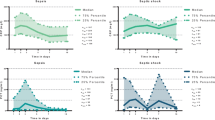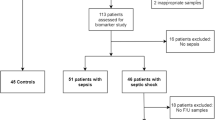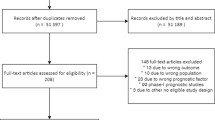Abstract
The diagnostic value of procalcitonin, C-reactive protein, tumor necrosis factor-alpha, and interleukin-10 levels in differentiating sepsis from severe sepsis and the prognostic value of these levels in predicting outcome were evaluated and compared in patients with community-acquired sepsis, severe sepsis, and septic shock in the first 72 h of admission to the hospital. Thirty-nine patients were included in the study. The severe sepsis and septic shock cases were combined in a single “severe sepsis” group, and all comparisons were made between the sepsis (n=21 patients) and the severe sepsis (n=18 patients) groups. Procalcitonin levels in the severe sepsis group were found to be significantly higher at all times of measurements within the first 72 h and were significantly higher at the 72nd hour in patients who died. Procalcitonin levels that remain elevated at the 72nd hour indicated a poor prognosis. C-reactive protein levels were not significantly different between the groups, nor were they indicative of prognosis. No significant differences in the levels of tumor necrosis factor-alpha were found between the sepsis and severe sepsis groups; however, levels were higher at the early stages (at admission and the 24th hour) in patients who died. Interleukin-10 levels were also higher in the severe sepsis group and significantly higher at all times of measurement in patients who died. When the diagnostic and prognostic values at admission were evaluated, procalcitonin and interleukin-10 levels were useful in discriminating between sepsis and severe sepsis, whereas tumor necrosis factor-alpha and interleukin-10 levels were useful in predicting which cases were likely to have a fatal outcome.


Similar content being viewed by others
References
Assicot M, Gendrel D, Carsin H, Raymond J, Guilbaud J, Bohuon C (1993) High serum procalcitonin concentrations in patients with sepsis and infection. Lancet 341:515–518
Becker KL, Nylen ES, White JC, Müller B, Snider RH (2004) Procalcitonin and the calcitonin gene family of peptides in inflammation, infection and sepsis: a journey from calcitonin back to its precursors. J Clin Endocrinol Metab 89:1512–1525
van Rossum AM, Wulkan RW, Ousdesluys-Murphy AM (2004) Procalcitonin as an early marker of infection in neonates and children. Lanset Infect Dis 4:620–630
Carrol ED, Thomson APJ, Hart CA (2002) Procalcitonin as a marker of sepsis. Int J Antimicrob Agents 20:1–9
Whicher J, Bienvenu J, Monneret G (2001) Procalcitonin as an acute phase marker. Ann Clin Biochem 38:483–493
Carlet J (1999) Rapid diagnostic methods in the detection of sepsis. Infect Dis Clin North Am 13:483–494
Gogos CA, Drosou E, Bassaris HP, Skoutelis A (2000) Pro-versus anti-inflammatory cytokine profile in patients with severe sepsis: a marker for prognosis and future therapeutic options. J Infect Dis 181:176–180
Schröder J, Staubach KH, Zabel P, Stüber F, Kremer B (1999) Procalcitonin as a marker of severity in septic shock. Langenbeck’s Arch Surg 384:33–38
Balcı C, Sungurtekin H, Gürses E, Sungurtekin U, Kaptanoğlu B (2003) Usefulness of procalcitonin for diagnosis of sepsis in the intensive care unit. Crit Care 7:85–90
Harbarth S, Holeckova K, Froidevaux C, Pittet D, Ricou B, Grau GE (2001) Diagnostic value of procalcitonin, interleukin-6, and interleukin-8 in critically ill patients admitted with suspected sepsis. J Respir Crit Care Med 163:396–402
Ruokonen E, Nousiainen T, Pulkki K, Takala J (1999) Procalcitonin concentrations in patients with neutropenic fever. Eur J Clin Microbiol Infect Dis 18:283–285
Chiesa C, Pellegrini G, Panero A, Osborn JF, Signore F, Assumma M et al (2003) C-reactive protein, interleukin-6, and procalcitonin in the immediate postnatal period: influence of illness severity, risk status, antanatal and perinatal complication, and infection. Clin Chem 49:68–68
Wunder C, Eichelbronner O, Roewer N (2004) Are IL-6, IL-10 and PCT plasma concentrations reliable for outcome prediction in severe sepsis? A comparison with APACHE III and SAPS II. Inflamm Res 53:158–163
American College of Chest Physicians/Society of Critical Care Medicine Consensus Conference (1992) Definitions for sepsis and organ failure and guidelines for the use of innovative therapies in sepsis. Crit Care Med 20:864–874
Meisner M, Tschaikowsky K, Palmaers T, Schmidt J (1999) Comparison of procalcitonin (PCT) and C-reactive protein (CRP) plasma concentrations at different SOFA scores during the course of sepsis and MODS. Crit Care 3:45–50
Müller B, Becker KL, Schachinger H, Rickenbacher PR, Huber PR, Zimmerli W et al (2000) Calcitonin precursors are reliable markers of sepsis in a medical intensive care unit. Crit Care Med 28:977–983
Clec’h C, Ferriere F, Karoubi P, Fosse JP, Cupa M, Hoang P et al (2004) Diagnostic and prognostic value of procalcitonin in patients with septic shock. Crit Care Med 32:1166–1169
Ruokonen E, Ilkka L, Niskanen M, Takala J (2002) Procalcitonin and neopterin as indicators of infection in critically ill patients. Acta Anaestesiol Scand 46:398–404
Ugarte H, Silva E, Mercan D, De Mendonca A, Vincent J (1999) Procalcitonin used as a marker of infection in the intensive care unit. Crit Care Med 27:498–504
Müller B, Becker KL (2001) Procalcitonin: how a hormone became a marker and mediator of sepsis. Swiss Med Wkly 131:595–602
Levy MM, Fink PM, Marshall JC, Abraham E, Angus D, Cook D, Cohen J, Opal SM, Vincent JL, Ramsay G (2003) 2001 SCCM/ESICM/ATS/SIS International sepsis definitions conference. Crit Care 31:1250–1256
Monneret G, Finck ME, Venet F, Debard AL, Bohe J, Bienvenu J, Lepape A (2004) The anti-inflammatory response dominates after septic shock: association of low monocyte HLA-DR expression and high interleukin-10 concentration. Immunol Lett 95:193–198
Dinarello CA (1997) Proinflammatory and anti-inflammatory cytokines as mediators in the pathogenesis of septic shock. Chest 112:321–329
Stanilova SA, Karakolev ZT, Dimov GS, Dobreva ZG, Miteva LD, Slavov ES, Stefanov CS, Stanilov NS (2005) High interleukin 12 and low interleukin 10 production after in vitro stimulation detected in sepsis survivors. Intensive Care Med 31:401–407
Lowe PR, Galley HF, Abdel-Fattah A, Webster NR (2003) Influence of interleukin-10 polymorphisms on interleukin-10 expression and survival in critically ill patients. Crit Care Med 31:34–38
Loisa P, Rinne T, Laine S, Hurme M, Kaukinen S (2003) Anti-inflammatory cytokine response and the development of multiple organ failure in severe sepsis. Acta Anaesthesiol Scand 47:319–325
Al-Nawas B, Kammer I, Shah PM (1996) Procalcitonin in diagnosis of severe infections. Eur J Med Res 1:331–333
Kotake Y, Moore DR, Vasquez-Walden A, Tabatabaie T, Sang H (2003) Antioxidant amplifies antibiotic protection in the cecal ligation and puncture model of microbial sepsis through interleukin-10 production. Shock 19:252–256
Manley MO, O’Riordan MA, Levine AD, Latifi SQ (2005) Interleukin 10 extends the effectiveness of standard therapy during late sepsis with serum interleukin 6 levels predicting outcome. Shock 23:521–526
Latifi SQ, O’Riordan MA, Levine AD (2002) Interleukin-10 controls the onset of irreversible septic shock. Infect Immun 70:4441–4446
Kahlke V, Dohm C, Mees T, Brotzmann K, Schreiber S, Schroder J (2002) Early interleukin-10 treatment improves survival and enhances immune function only in males after hemorrhage and subsequent sepsis. Shock 18:24–28
Wunderink RG, Waterer GW (2003) Genetics of sepsis and pneumonia. Curr Opin Crit Care 9:384–389
Acknowledgement
This study was supported by a grant from Uludag University (Scientific Research Project, grant no: T-2002/7).
Author information
Authors and Affiliations
Corresponding author
Rights and permissions
About this article
Cite this article
Heper, Y., Akalın, E.H., Mıstık, R. et al. Evaluation of serum C-reactive protein, procalcitonin, tumor necrosis factor alpha, and interleukin-10 levels as diagnostic and prognostic parameters in patients with community-acquired sepsis, severe sepsis, and septic shock. Eur J Clin Microbiol Infect Dis 25, 481–491 (2006). https://doi.org/10.1007/s10096-006-0168-1
Published:
Issue Date:
DOI: https://doi.org/10.1007/s10096-006-0168-1




